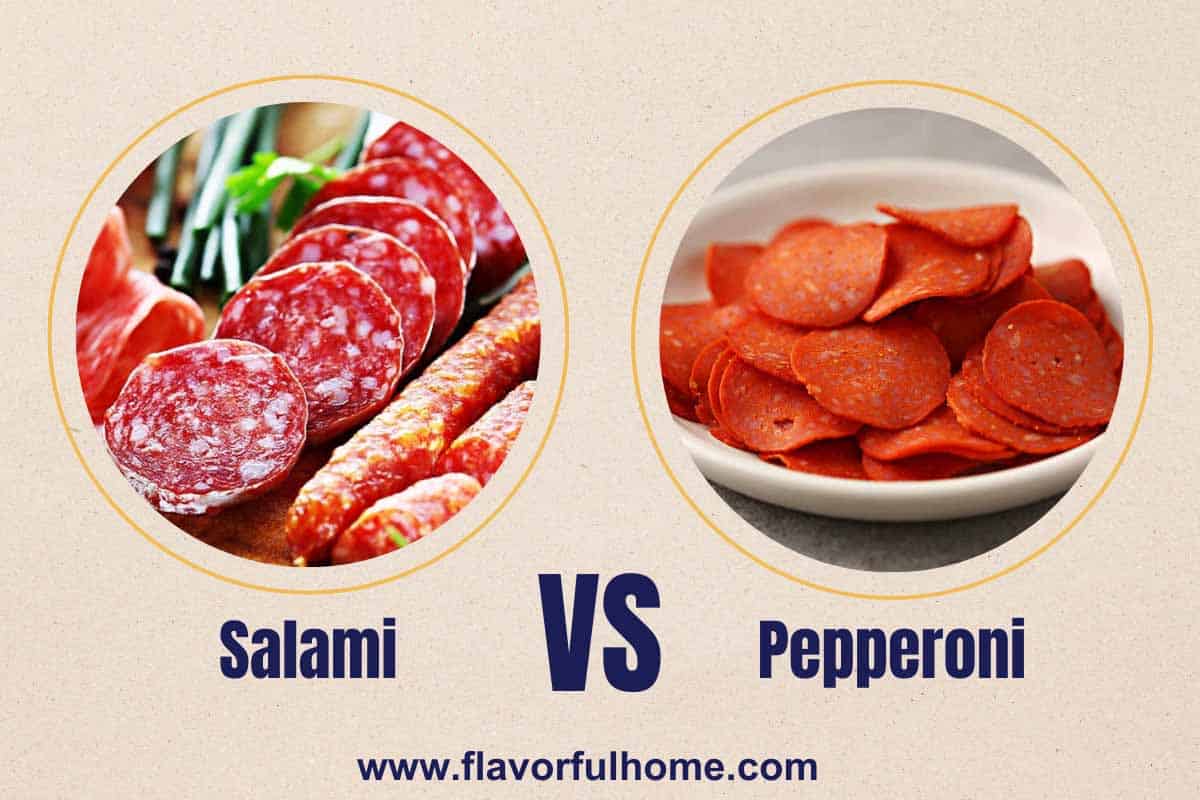In this article, we’ll explore the differences between salami vs. pepperoni. We’ll also help you decide which is suitable for your next meal. While they may look similar, they have distinct tastes, textures, and preparation differences.

Knowing the difference between these two deli types of meat is important for several reasons.
The comparison can help you make informed decisions about which one to use in your cooking. It also gives you a better idea of which best suits your taste preferences and dietary needs.
You must remember that these two have distinct flavors and spiciness. These factors can affect the overall taste of a dish. And using one instead of the other can make or break your recipe.
Also, salami and pepperoni have different nutritional values. They may differ in levels of fat, sodium, and protein. These factors can affect dietary choices.
Lastly, depending on your location, one of these meats may be more available than the other.
Salami is a cured sausage, so it has an elongated shape. Before serving salami, people usually slice it to make flat circles.
It comes from Italy, so, unsurprisingly, it is an integral part of Italian cuisine. The word “salami” comes from the Italian word “salume,” which means salted meats.
There are different types of salami. Each has different ingredients, preparation methods, and curing processes.
Some kinds of salami have complex spice blends, while others are simpler.
Traditional salami only has pork, but salami can now come from various types of meat. Some even include horse meat, so it is always important to read the labels when buying salami.
The right proportion of lean meat and fat is critical to make the best salami.
Salami producers season and cure the meat. Then, they chop the meat, stuff them into casings, and air-dry. The air-drying process can take days, months, or even years.
Chorizo
Chorizo is a Spanish-style salami. This type of salami usually has smoked paprika, garlic, and other spices as seasonings. There are two types: Mexican and Spanish. Mexican chorizo is fresh and uncooked, so you must cook it before eating.
Spanish chorizo undergoes a curing process, making it safe to eat without cooking. This type of chorizo has a bold flavor and smoky undertones.
Felino Salami
Felino salami is an Italian salami known for its smooth consistency and rich flavor. This type of salami does not have a lot of spices. But it contains peppercorns and wine.
And it undergoes a slow aging process that brings out a sweet flavor. It is bright red, with coarse ground lean pork and fat speckled throughout.
Sopressata
Sopressata is a simple Italian salami with a smooth texture and bold flavor. It has two types: mild and spicy versions. People make both types by grinding pork, adding spices, encasing them, and hanging them to dry.
The mild version uses black peppercorns. And the second version gets its spicy flavor from Calabrian red peppers.
Genoa Salami
Genoa salami is a smooth salami with a clean finish. Its medium grind and rich garlicky flavor make it a good recipe addition.
It usually comes from a combination of pork, sea salt, sugar, and spices. Natural flavorings and garlic are also common ingredients in a Genoa salami.
Salami has a spicy and rich flavor that can enhance the taste of sandwiches and pizzas. It also has a fatty mouthfeel with acidic notes due to fermentation. Thanks to its salty and porky flavor, it melds well with lots of other dishes.
Of course, each salami has specific flavor notes; it all depends on the spices they contain. For instance, fennel seeds can give an anise flavor. Black peppers or chili peppers can make salami spicy. Lastly, wine or cinnamon can add a sweeter, earthier taste.
Salami is a versatile food you can serve with bread and cheese. You may also use it to flavor savory pies, casseroles, and pasta dishes. People also use it as an appetizer and as part of most restaurant antipasti.
This cured meat is also a great accompaniment to wine. Spicy salamis pair well with hard cheeses, while soft salami complements fresh fruits.
Salami contains vitamin B12 and niacin. This deli meat is also rich in zinc and protein. But note that salami is still processed meat, so it has high levels of sodium and fat. It can be part of a healthy diet, but as always, moderation is key to getting the benefits of salami.

Pepperoni is a cured sausage people make from beef and pork. It has a specific meat-to-fat ratio of 70:30.
Pepperoni is specific when it comes to texture as well. For this reason, the meat and fat should measure only 2 to 3 millimeters after grinding.
Makers of this sausage add salt, sugar, and spices to the meat. Then, they add lactobacillus bacteria to produce lactic acid.
After stuffing them into casings, makers leave the sausages hanging in a smokehouse. The smoking and drying process then follows.
After aging for several days, manufacturers pack and sometimes slice the sausage.
There are several types of pepperoni meats. According to meat type, beef, pork, turkey, and venison pepperoni are the most popular.
There are also pepperoni sticks and cubes. Cupping and lay-flat varieties also exist. The cupping pepperoni forms a cup when you bake it with the pizza; that way, it holds grease. The lay-flat kind does not curl up, so it stays flat on the pizza even after baking.
Versions with gluten-free, low-sodium, and plant-based ingredients are also available.
Pepperoni’s flavor profile combines salty, spicy, and tangy notes. After all, this sausage uses salt, spices, and lactic acid in the curing process.
Paprika, garlic powder, and sugar are common additions to pepperoni. Each ingredient offers a distinct flavor to the sausage as well.
Some manufacturers also add fennel seeds to enhance pepperoni’s taste. Again, each pepperoni type will have different flavor profiles depending on its ingredients.
Pepperoni is a versatile ingredient used in various cuisines. It is widely known as a pizza topping but has many uses beyond that.
You can add it to charcuterie boards and antipasto platters. Pepperonis are also great ingredients in baked potato, pasta salad, and quesadilla recipes. You may also grate them to use them as garnish to dishes like pasta salads and soups.
Pepperoni is a nutritious food with vitamins C, D, and E.
This spicy sausage also contains amino acids and protein. But remember that processed meats like pepperoni have lots of calories and nitrates. They are delicious, but it is best if you will not overindulge.

Salami and pepperoni differ when it comes to the meat used. Pepperoni typically includes a combination of pork and beef meat trimmings. On the other hand, people can make salami from a blend of pork, beef, veal, and sometimes poultry.
Pepperoni is typically spicier than salami. This flavor is unsurprising, as it usually has cayenne pepper, paprika, and chili pepper. Garlic, fennel, white pepper, and anise seed are also common pepperoni ingredients.
Salami has a milder taste. After all, most salamis only have black pepper, powdered garlic, vinegar, white wine, and salt. Also, pepperoni is always lightly smoky, while salami may or may not be smoky.
Pepperoni typically has a slightly softer and more tender texture. Salami tends to be denser and firmer than pepperoni. The texture is fine-grained and uniform, while salami may be coarser.
Sometimes, salami still has visible chunks of fat and meat. That said, salami is a lot harder to chew than pepperoni in most cases.
Salami and pepperoni can differ in size and shape as well. Salami is typically larger and has a cylindrical shape. Pepperoni is smaller and thinner, but both yield circular shapes after cutting across.
Salami and pepperoni differ in their smoking and curing processes. Salami is typically dry-cured.
People hang salami sausages in a controlled environment with specific temperatures and humidity. Doing so slowly dries and cures the salami over several weeks or months.
On the other hand, pepperoni is usually just semi-dried. Pepperoni makers typically smoke the sausages for a few hours and dry them by hanging them.
Salami is a traditional Italian cured meat. As a result, there are wide regional varieties throughout Italy. There is Genoa salami, soppressata, and finocchiona.
Each of these salamis has unique flavors and textures. These factors depend on the region and local ingredients they contain.
On the other hand, pepperoni comes from the United States. It is also popular in other parts of the world. But people primarily associate it with American cuisine.

Deciding whether to use salami or pepperoni in a dish can depend on personal preference. The specific flavor profile and texture you’re looking for also play a role in this decision.
Salami is a versatile meat you can add to sandwiches, antipasto platters, and pasta salads. It has a milder flavor profile and a firmer texture, too.
That said, it is also ideal for slicing thinly and layering in dishes. You can wrap salami around cheese and vegetables as well.
On the other hand, pepperoni is a spicier and softer meat people usually add as a pizza topping or in sandwiches. Its distinct flavor profile makes it a good choice for dishes requiring heat. For this reason, it is a better choice for spicy quesadillas or baked pasta dishes.
The decision between salami and pepperoni boils down to your preference and dish. Experimenting with both types of meat can help determine which works best.
It depends on the pizza recipe and personal preference. In the US, pepperoni is a popular pizza topping. But when you come to Italy, salami is more popular. For this reason, whether it is pepperoni or salami you need to use in a pizza recipe, it comes down to a matter of choice. But of course, a pepperoni pizza would always call for pepperoni instead of any other salami.
Pepperoni is a better choice for you if you like spicier flavors. But if you prefer a milder taste, salami might be your preferred ingredient. Both deli meats are delicious in their own right. They can add a savory, meaty flavor to recipes, so there is no better meat when it comes to pepperoni and salami.
No. The opposite is true. As mentioned, pepperoni is a type of spicy salami, so pepperoni is basically salami. But salami is not basically pepperoni. After all, there are other types of salami besides pepperoni. All pepperonis are salami, but not all salamis are pepperoni.
Salami and pepperoni are two cured sausages that have distinct differences. People make salami with various types of meat, including horse and pork meat. It has a spicy, rich flavor and is versatile enough for several dishes.
On the other hand, pepperoni is an American smoked sausage made from beef and pork, with a smoky and sweet taste. Each has different nutritional values and flavor profiles. So, choosing whether to use salami vs. pepperoni is important for each dish.





